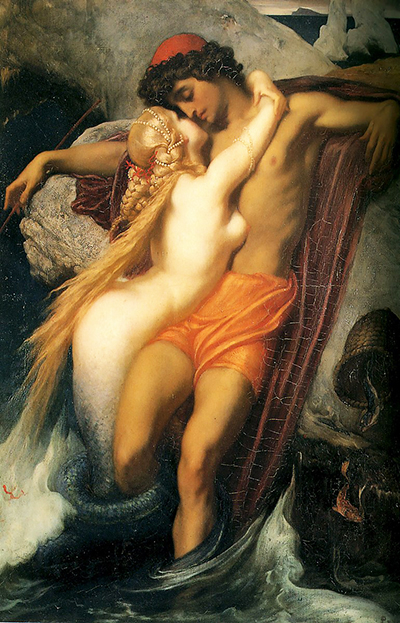The Fisherman and the Siren is one of Frederic Leighton's most remarkable works. The painting depicts a fisherman in deep embrace with a mermaid. The fisherman's pale body presses relentlessly to the mermaid. The the physical contact raises a powerful impact.
The Fisherman and the Mermaid has earned critical acclaim for its rich imagery and allegory. Frederic Leighton tells the story of a mermaid who lures the fisherman down to his death, in retribution for the death of her fish. The fisherman entwined with the siren-mermaid reprseents the seductive and destructive power of female sexuality. Leighton depicts the unforgiving and deathly embrace brilliantly. The pressure and weight of the bodies allegories the sensual yet deathly embrace of female sexuality. Even a causal observer understands the symbolism and allegory.
Frederic Leighton's attention to detail is remarkable. The fisherman, clothed in a red lion cloth and skull cap, lies on a red mantle set against the rocks. His ankles are already submerged in water and the body all set to slide down into the sea. His head is already slumped to one side, and the arms stretched out, as if in a crucifix. The fisherman's resemblance to a secular Christ figure is striking. The dark, rough sea, depicted brilliantly in the background, adds to the aura of the painting.
Frederic Leighton painted The Fishermen and the Siren in 1856, when he lived in Paris. It is one of his earlier works. The work is typical of Leighton's classical style. Critics admire his rich imagery, extensive depth, and attention to detail. True to form, the painting depicts sharp, vivid imagery and a high degree of colour accuracy. Frederic Leighton first exhibited the The Fisherman and the Siren in London's Royal Academy of Arts in 1858. Underneath the painting, he displayed a famous quote from Goethe's ballad: "Half drew she him, half sunk he in, and never more was seen." The release coincided with the public's interest in Greek culture, ensuring success.
Sir Frederich Leighton (1830-1896) was one of the leading Victorian painters. He was also a brilliant draughtsman, illustrator, and a sculptor. He developed as an artist under the patronage of famous European artists, such as Eduard von Steinle and Giovanni Costa. He soon established a reputation for his distinctive themes. He carved out a niche in historical, biblical, and classical matters. The Nazarenes and the Italian Renaissance influenced him most. He spent his early career in the continent, in Florence and Italy. In 1860, he returned to London. He soon stamped his authority as the leading Victorian painter of his times. He remained the president of the Royal Academy for 20 years.




